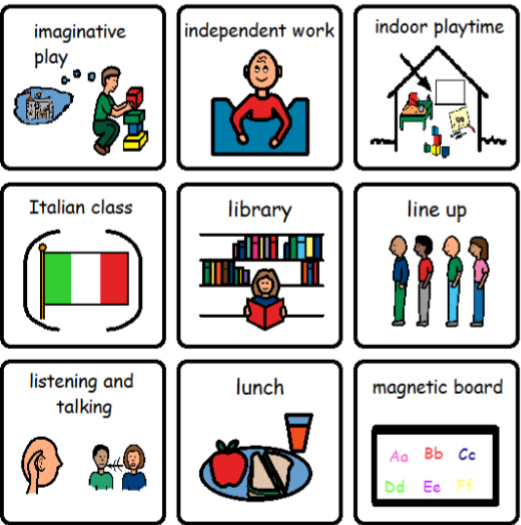Visual Supports
Visual supports can be very helpful in helping learners with a range of additional support needs. They support communication and can be used in various environments and locations and in many situations. For some autistic learners they are a vital communication support. It is helpful to have consistency at home and in the early learning and childcare setting/school when using visual supports.
Some of the benefits of using visuals for children and young people include:
- Creating a shared understanding of the day
- Providing structure, routine and predictability by showing what is coming next
- Supporting communication – both expressive and receptive
- Promoting classroom and personal organisation
- Encouraging independence
- Improving understanding
- Building confidence
- Reducing frustration and anxiety
- Helping with consistency across home, the educational setting and the community
Visual supports can be presented in a variety of ways and using a variety of content. For example they can be created very easily with:
- Drawings
- Photographs, including photographs of objects and rooms/areas the autistic learner uses
- Symbols
- Clip art
- Objects
- Written word
Visual supports can be printed and laminated on A4 size paper or made smaller and attached to a keyring which is accessible by the learner. Staff may carry a keyring as well to prompt and model use.
Visual Supports are commonly used for:
- Timetables
- Schedules
- Choice boards
- Helping a learner communicate how they are feeling
- Health and safety communication
- Supporting social communication e.g. visual scripts
- Offering a range of coping strategies.

As visuals can take a variety of forms, in order for them to be effective, it is important to ensure that visuals are carefully selected to appropriately meet the learners’ level of communication development. So, for example, objects are most likely to be the most effective form of visual support for learners at the pre-verbal stage of communication development, who are unlikely to have developed symbolic understanding which is required to understand symbols or words.
It can be tempting not to use visual supports with cognitively able or more competent communicators. However, visual supports can go a long way in heling to avoid a build-up of anxiety and stress.
Autistic learners are likely to benefit from developmentally appropriate visual supports. Personalised approaches can be explored during transition planning, parental/carer meetings, professional meetings and of course with the learner who may have their own preferences of presentation styles and images. Speech and language therapists are well placed to advise on an individual’s stage of communication development and what types of visuals would be most suitable.
Further information and access to a range of free downloadable visual supports is available in the Resources section of the Autism Toolbox
All autistic learners are likely to benefit from developmentally appropriate visual supports. This information can be explored during transition planning, parental/carer meetings, professional meetings and of course with the learner who may have their own preferences of presentation styles and images.
How to use a visual timetable (click here)
Consistency of practice across adults and settings is vital when using visuals to effectively support individuals. This film explains a consistent approach to using a visual timetable.
Alternative and augmentative communication aids (AAC) (click here)
Not all children and young people will be at the stage of development in which they can communicate verbally. It is important that appropriate supports are put in place to ensure that individuals have a system to communicate which meets their developmental stage.
Adaptations may include use of alternative or augmentative communication aids (AAC). A thorough and robust assessment of an individual’s needs should be conducted to ensure that the most suitable technology is selected.
AAC may include (but is not limited to):
- ‘Low Tech’ supports, such as ‘Objects of Reference’ or symbols
- ‘Medium Tech’ supports, such as message devices which can be used to press buttons and listen to pre-recorded messages.
- ‘High Tech’ supports, such as touchscreens, Switches and Switch Boxes or Eye Gaze Technology
Further information and resources
Further information and access to a range of free downloadable visual supports is available in the Resources section of this Toolbox.
The National Autism Implementation Team (NAIT) have created a series of guides and visual symbol supports:
Home-Visual-Support-guides-for-Social-Partners.pdf (thirdspace.scot)
CALL Scotland offer further information and guidance around assistive technology, as well as free online modules for professionals: https://www.aacscotland.org.uk/modules/
Further information and access to a range of free downloadable visual supports is available in the Resources section of this Toolbox.
A series of films about symbolisation of the school environment are available here.
